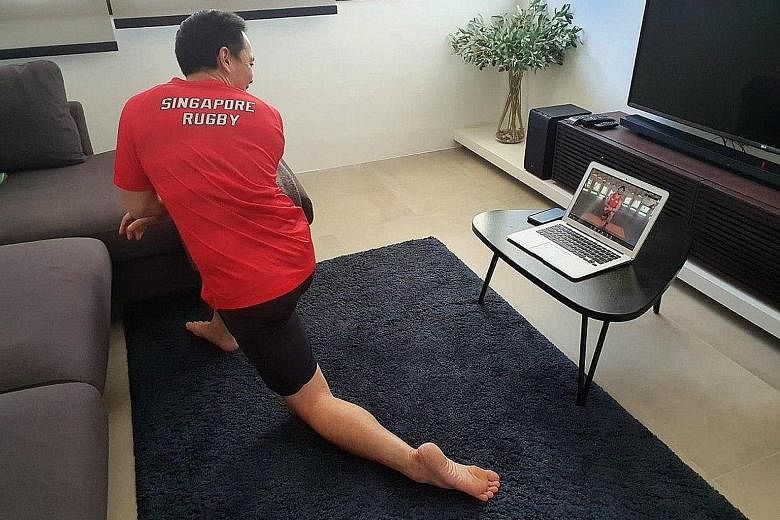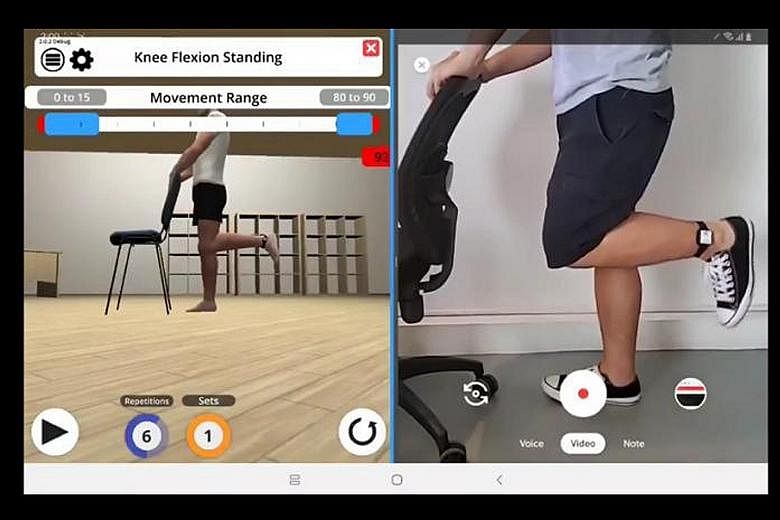Since Covid-19 circuit breaker measures kicked in on April 7, national rugby player Jay-Hykel Jailani has not visited his physiotherapist Reginald Tang.
Now, their weekly sessions to treat an ulcer in Jay-Hykel's left knee cap are done online over video conferencing software Zoom.
As physiotherapy is not considered an essential service, clinics have been shut till June 1 following the extension of circuit breaker measures yesterday, so many are offering tele-rehabilitation instead. This allows patients to be seen and diagnosed remotely by physiotherapists through virtual platforms.
But even as they find ways to continue seeing clients, business has been hit hard, with the roster of patients dwindling significantly.
Private clinics that The Straits Times spoke to saw a 60 to 90 per cent decrease in clients during this period.
Given the severity of the current situation, with Singapore reporting over 9,000 coronavirus cases and 11 deaths up till yesterday, many clients have opted to reschedule their appointments till after the circuit breaker period ends.
In a job that relies heavily on physical contact, physiotherapists now have to trust what they see and hear over video calls to assist clients in their recovery.
Without physical examinations, ascertaining the problems that patients are grappling with can be challenging.
Tang, a senior physiotherapist at Physio Solutions, explained: "During physical examinations, you can feel the difference between right and left sides when testing the physical strength of a muscle. When you are doing it online, it's not as affirmative."
This has forced physiotherapists to think of alternative ways to identify clients' conditions.
Heartland Physio has partnered health technology company XCLR8 Technologies to come up with wearable technology called Rebee.
-
40%
Of patients' diagnosis is by touch.
The device, which is still a prototype and operated via an app, is worn on the joint that is being treated and data such as range of movement, speed and accuracy is recorded when patients exercise.
The data is then uploaded on to a programme that both practitioners and patients can access, allowing the physiotherapists to remotely monitor and modify the home exercise programmes.
Balaji Prem Chand, director and principal sports physiotherapist at Heartland Physio, said: "This helps to track if patients are doing their exercises in good form. Sometimes, although we give exercises for patients to do, they don't do it or forget how to do it so this helps to mitigate that."
Others have found the need to be more descriptive when trying to gauge their clients' conditions or demonstrate exercises to them.
Tang got one of his clients to use ankle weights as resistance, starting with 1kg on both sides and gradually increasing the load to see which one caused more problems.
Muhammad Nifail Zainal, the lead physiotherapist at Get Moving, sometimes does the exercises with his clients. Because he cannot do physical examinations now, he depends on his patients to do the hands-on part of the sessions for him, guiding them along using bony landmarks - grooves or prominences found on bones.
While they have come up with ways to circumvent the constraints of tele-consultations, some like Sharon Lim, a sports physiotherapist at Moving Space, have decided to be more selective with the patients they see.
"The touch component is 30 to 40 per cent of how we form our diagnosis, and without that, our diagnosis may not be accurate, so we're selective with the patients we deal with," said Lim, who has served as the sports physiotherapist for the Team Singapore contingent at several major Games.
She sees patients who would benefit from tele-consultations as follow-up appointments, even if they are seeking treatment for a different problem, as she is more familiar with the way their bodies work. Other cases she is more confident in dealing with are exercise-based treatments such as those for anterior knee pains, which are more easily identifiable based on the descriptions provided.
With physiotherapists being more cautious now, recovery may take a little longer for some.
Jay-Hykel had been making decent progress since he started seeing Tang in February and was looking forward to making a full recovery by August.
He was able to do proper squats, which used to cause him severe pain last year, and with his knee responding well, Tang gave him more exercises to do.
But now that face-to-face sessions have stopped, the winger has not done new exercises as it is harder for Tang to assess how his knee is doing.
He said: "It does get a bit frustrating because I started seeing progress for the first time in a long time and I wanted to do more, but I can't now. But I'm still positive, 1 or 2 per cent of progress is better than nothing."
Assisting clients who have recently gone for surgery or suffer from acute injuries is also harder to do virtually.
Nifail said: "The first three to six weeks post-surgery are important and we tend to have a lot of hands-on sessions. Part of the assessment is to palpate the area, see if there's swelling, see if the range is all right and when you are unable to do that properly, it's difficult."
However, there have been some exceptions. Lim was granted an exemption for one of her patients who went for anterior cruciate ligament reconstruction surgery about two weeks ago, although her application for an exemption to see a patient who recently had shoulder surgery was rejected.
Seeing patients who have just done back or neck surgeries is also complicated.
Although Jenny Huang, founder of HelloPhysio, has not had to look at such cases during the circuit breaker period, she stressed the importance of knowing which cases can or cannot be managed over virtual platforms.
She said: "It's important to note the difference between those who can be seen through tele-health and someone who requires a hands-on (consultation) to prevent disability in the long term."
The Singapore Sport Institute (SSI) has also moved its physiotherapy and rehabilitation sessions with national athletes online.
National netballer Kimberly Lim had been going for three rehabilitation and two physiotherapy sessions a week at the SSI for her torn Achilles tendon since February, but is now currently doing her sessions at home.
She can no longer exercise on the anti-gravity machine, which she was using at SSI to reduce the impact on her Achilles tendon as it still is not strong enough for running and jumping.
While tele-consultations have not begun for her, she sends videos to her physiotherapist if she is unsure about anything. Lim has also been using a portable electrical muscle stimulation unit provided by the institute to help strengthen her muscles.
She said: "I'd never known anyone with an Achilles injury before, so it makes me quite scared to do my own rehab at home because I'm not sure how much I should push. But the physiotherapist is always there to help me whenever I send videos over. We're doing the best that we can."













